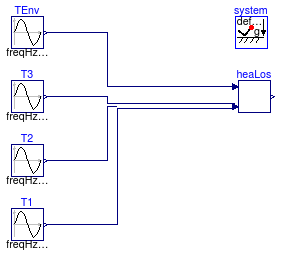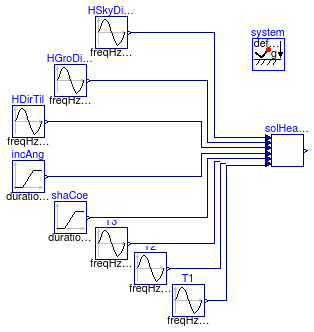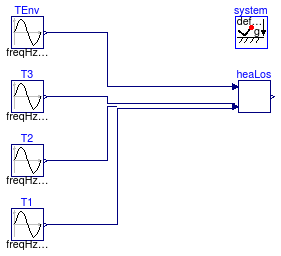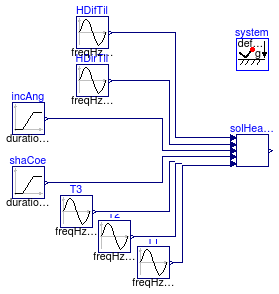

This package contains examples for the use of models that can be found in Buildings.Fluid.SolarCollectors.BaseClasses.
Extends from Modelica.Icons.ExamplesPackage (Icon for packages containing runnable examples).| Name | Description |
|---|---|
| Example showing the use of ASHRAEHeatLoss | |
| Example showing the use of ASHRAESolarGain | |
| Example showing the use of EN12975HeatLoss | |
| Example showing the use of EN12975SolarGain |
 Buildings.Fluid.SolarCollectors.BaseClasses.Examples.ASHRAEHeatLoss
Buildings.Fluid.SolarCollectors.BaseClasses.Examples.ASHRAEHeatLoss
This examples demonstrates the implementation of Buildings.Fluid.SolarCollectors.BaseClasses.ASHRAEHeatLoss.
Extends from Modelica.Icons.Example (Icon for runnable examples).
| Type | Name | Default | Description |
|---|---|---|---|
| GenericSolarCollector | per | Buildings.Fluid.SolarCollect... | Performance data |
model ASHRAEHeatLoss "Example showing the use of ASHRAEHeatLoss"
extends Modelica.Icons.Example;
parameter Buildings.Fluid.SolarCollectors.Data.GenericSolarCollector per=
Buildings.Fluid.SolarCollectors.Data.GlazedFlatPlate.FP_SolahartKf()
"Performance data";
inner Modelica.Fluid.System system(p_ambient=101325);
Modelica.Blocks.Sources.Sine TEnv(
freqHz=0.01,
offset=273.15 + 10,
amplitude=7.5) "Temperature of the surrounding environment";
Modelica.Blocks.Sources.Sine T1(
freqHz=0.1,
amplitude=15,
offset=273.15 + 10) "Temperature in the first segment";
Modelica.Blocks.Sources.Sine T2(
freqHz=0.1,
amplitude=15,
offset=273.15 + 15) "Temperature in the second segment";
Modelica.Blocks.Sources.Sine T3(
freqHz=0.1,
amplitude=15,
offset=273.15 + 20) "Temperature in the third segment";
Buildings.Fluid.SolarCollectors.BaseClasses.ASHRAEHeatLoss heaLos(
nSeg=3,
m_flow_nominal=per.mperA_flow_nominal*per.A,
redeclare package Medium = Buildings.Media.ConstantPropertyLiquidWater,
G_nominal=per.G_nominal,
dT_nominal=per.dT_nominal,
A_c=per.A,
y_intercept=per.y_intercept,
slope=per.slope) "Heat loss model using ASHRAE93 calculations";
equation
connect(TEnv.y, heaLos.TEnv);
connect(T3.y, heaLos.TFlu[3]);
connect(T2.y, heaLos.TFlu[2]);
connect(T1.y, heaLos.TFlu[1]);
end ASHRAEHeatLoss;
 Buildings.Fluid.SolarCollectors.BaseClasses.Examples.ASHRAESolarGain
Buildings.Fluid.SolarCollectors.BaseClasses.Examples.ASHRAESolarGain
This examples demonstrates the implementation of Buildings.Fluid.SolarCollectors.BaseClasses.ASHRAESolarGain.
Extends from Modelica.Icons.Example (Icon for runnable examples).
| Type | Name | Default | Description |
|---|---|---|---|
| GenericSolarCollector | per | Buildings.Fluid.SolarCollect... | Performance data |
model ASHRAESolarGain "Example showing the use of ASHRAESolarGain"
extends Modelica.Icons.Example;
parameter Buildings.Fluid.SolarCollectors.Data.GenericSolarCollector per=
Buildings.Fluid.SolarCollectors.Data.GlazedFlatPlate.FP_ThermaLiteHS20()
"Performance data";
inner Modelica.Fluid.System system(p_ambient=101325);
Buildings.Fluid.SolarCollectors.BaseClasses.ASHRAESolarGain solHeaGai(
nSeg=3,
shaCoe=0,
use_shaCoe_in=true,
A_c=per.A,
y_intercept=per.y_intercept,
B0=per.B0,
B1=per.B1,
redeclare package Medium = Buildings.Media.ConstantPropertyLiquidWater,
til=0.78539816339745) "Solar heat gain model using ASHRAE 93 calculations";
Modelica.Blocks.Sources.Sine HGroDifTil(
amplitude=50,
freqHz=4/86400,
offset=100) "Diffuse radiation from the ground, tilted surface";
Modelica.Blocks.Sources.Ramp incAng(duration=86400, height=60*(2*Modelica.Constants.pi
/360)) "Incidence angle";
Modelica.Blocks.Sources.Sine HDirTil(
offset=400,
amplitude=300,
freqHz=2/86400) "Direct beam radiation, tilted surface";
Modelica.Blocks.Sources.Sine HSkyDifTil(
freqHz=1/86400,
amplitude=100,
offset=100) "Diffuse radiation, tilted surface";
Modelica.Blocks.Sources.Ramp shaCoe(
height=-1,
duration=86400,
offset=1) "Shading coefficient";
Modelica.Blocks.Sources.Sine T3(
freqHz=2/86400,
amplitude=50,
offset=273.15 + 110);
Modelica.Blocks.Sources.Sine T2(
freqHz=2/86400,
amplitude=50,
offset=273.15 + 100);
Modelica.Blocks.Sources.Sine T1(
freqHz=2/86400,
amplitude=50,
offset=273.15 + 90);
equation
connect(HGroDifTil.y, solHeaGai.HGroDifTil);
connect(shaCoe.y, solHeaGai.shaCoe_in);
connect(incAng.y, solHeaGai.incAng);
connect(HDirTil.y, solHeaGai.HDirTil);
connect(HSkyDifTil.y, solHeaGai.HSkyDifTil);
connect(T3.y, solHeaGai.TFlu[3]);
connect(T2.y, solHeaGai.TFlu[2]);
connect(T1.y, solHeaGai.TFlu[1]);
end ASHRAESolarGain;
 Buildings.Fluid.SolarCollectors.BaseClasses.Examples.EN12975HeatLoss
Buildings.Fluid.SolarCollectors.BaseClasses.Examples.EN12975HeatLoss
This examples demonstrates the implementation of Buildings.Fluid.SolarCollectors.BaseClasses.EN12975HeatLoss.
Extends from Modelica.Icons.Example (Icon for runnable examples).
| Type | Name | Default | Description |
|---|---|---|---|
| GenericSolarCollector | per | Buildings.Fluid.SolarCollect... | Performance data |
model EN12975HeatLoss "Example showing the use of EN12975HeatLoss"
extends Modelica.Icons.Example;
parameter Buildings.Fluid.SolarCollectors.Data.GenericSolarCollector per=
Buildings.Fluid.SolarCollectors.Data.Concentrating.C_VerificationModel()
"Performance data";
Modelica.Blocks.Sources.Sine TEnv(
freqHz=0.01,
offset=273.15 + 10,
amplitude=15) "Temperature of the surrounding environment";
Modelica.Blocks.Sources.Sine T1(
amplitude=15,
freqHz=0.1,
offset=273.15 + 10) "Temperature of the first segment";
Modelica.Blocks.Sources.Sine T2(
freqHz=0.1,
amplitude=15,
offset=273.15 + 15) "Temperature of the second segment";
Modelica.Blocks.Sources.Sine T3(
freqHz=0.1,
amplitude=15,
offset=273.15 + 20) "Temperature of the third segment";
Buildings.Fluid.SolarCollectors.BaseClasses.EN12975HeatLoss heaLos(
nSeg=3,
redeclare package Medium = Buildings.Media.ConstantPropertyLiquidWater,
C1=per.C1,
C2=per.C2,
m_flow_nominal=per.mperA_flow_nominal*per.A,
G_nominal=per.G_nominal,
dT_nominal=per.dT_nominal,
A_c=per.A,
y_intercept=per.y_intercept) "Heat loss model using EN12975 calculations";
inner Modelica.Fluid.System system;
equation
connect(TEnv.y, heaLos.TEnv);
connect(T3.y, heaLos.TFlu[3]);
connect(T2.y, heaLos.TFlu[2]);
connect(T1.y, heaLos.TFlu[1]);
end EN12975HeatLoss;
 Buildings.Fluid.SolarCollectors.BaseClasses.Examples.EN12975SolarGain
Buildings.Fluid.SolarCollectors.BaseClasses.Examples.EN12975SolarGain
This examples demonstrates the implementation of Buildings.Fluid.SolarCollectors.BaseClasses.EN12975SolarGain.
Extends from Modelica.Icons.Example (Icon for runnable examples).
| Type | Name | Default | Description |
|---|---|---|---|
| GenericSolarCollector | per | Buildings.Fluid.SolarCollect... | Performance data |
model EN12975SolarGain "Example showing the use of EN12975SolarGain"
extends Modelica.Icons.Example;
parameter Buildings.Fluid.SolarCollectors.Data.GenericSolarCollector per=
Buildings.Fluid.SolarCollectors.Data.Concentrating.C_VerificationModel()
"Performance data";
inner Modelica.Fluid.System system(p_ambient=101325);
Buildings.Fluid.SolarCollectors.BaseClasses.EN12975SolarGain solHeaGai(
B0=per.B0,
B1=per.B1,
y_intercept=per.y_intercept,
nSeg=3,
A_c=per.A,
iamDiff=per.IAMDiff,
shaCoe=0,
use_shaCoe_in=true,
redeclare package Medium = Buildings.Media.ConstantPropertyLiquidWater)
"Solar heat gain model using EN12975 calculations";
Modelica.Blocks.Sources.Ramp incAng(duration=86400,
height=60*(2*Modelica.Constants.pi/360)) "Incidence angle";
Modelica.Blocks.Sources.Sine HDirTil(
offset=400,
amplitude=300,
freqHz=2/86400) "Direct beam radiation, tilted surface";
Modelica.Blocks.Sources.Sine HDifTil(
amplitude=200,
freqHz=1/86400,
offset=300) "Diffuse radiation, tilted surface";
Modelica.Blocks.Sources.Ramp shaCoe(
duration=86400,
offset=1,
height=-1) "Shading coefficient";
Modelica.Blocks.Sources.Sine T3(
freqHz=2/86400,
amplitude=50,
offset=273.15 + 110);
Modelica.Blocks.Sources.Sine T2(
freqHz=2/86400,
amplitude=50,
offset=273.15 + 100);
Modelica.Blocks.Sources.Sine T1(
freqHz=2/86400,
amplitude=50,
offset=273.15 + 90);
equation
connect(incAng.y, solHeaGai.incAng);
connect(shaCoe.y, solHeaGai.shaCoe_in);
connect(HDirTil.y, solHeaGai.HDirTil);
connect(HDifTil.y, solHeaGai.HSkyDifTil);
connect(T3.y, solHeaGai.TFlu[3]);
connect(T2.y, solHeaGai.TFlu[2]);
connect(T1.y, solHeaGai.TFlu[1]);
end EN12975SolarGain;